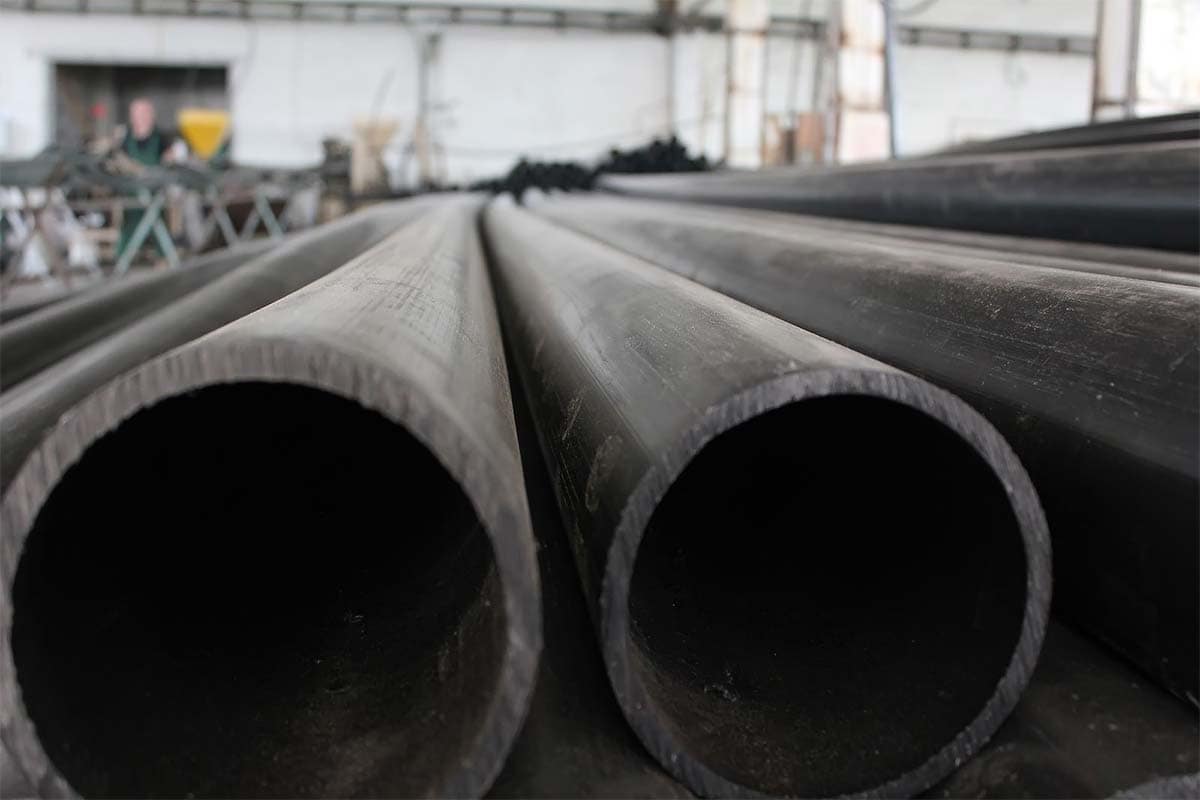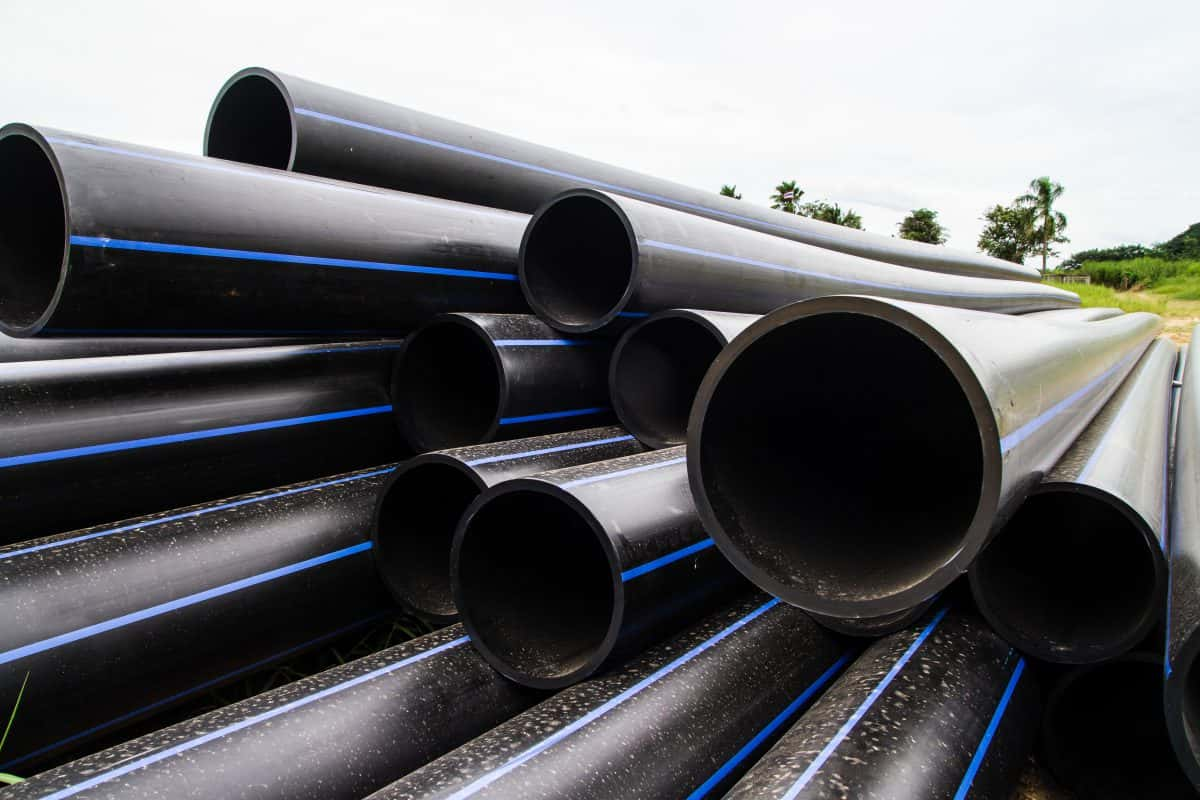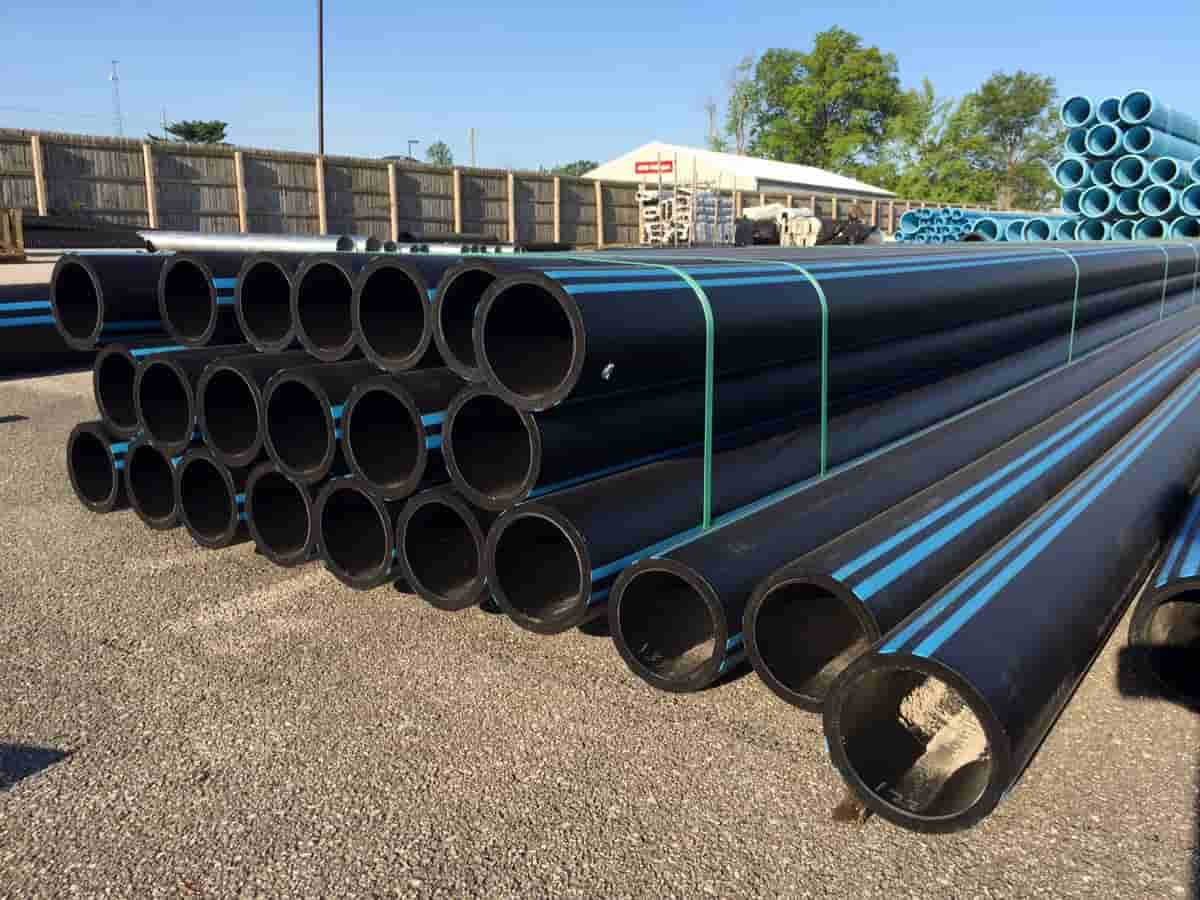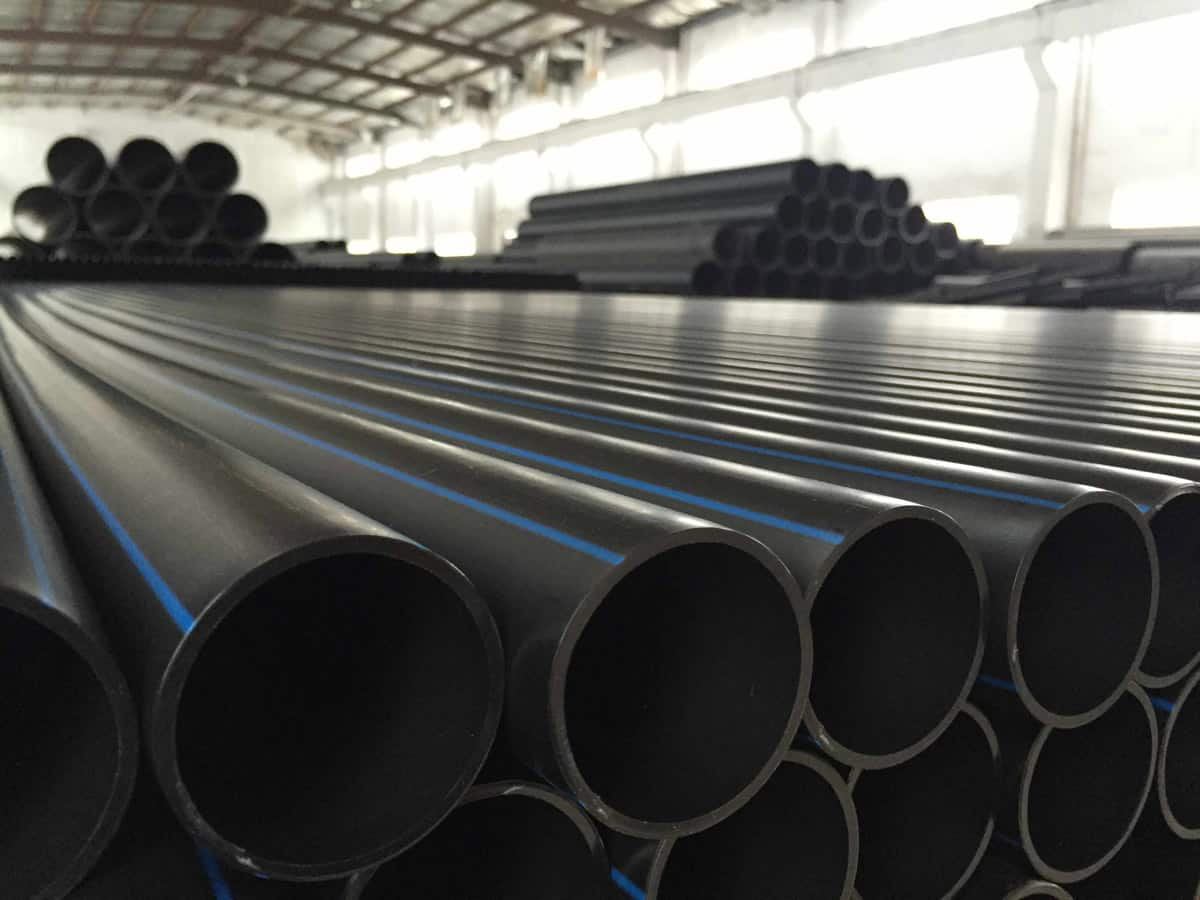The size and dimension of polyethylene pipes influence their diameter. The following are the standard polyethylene pipe diameter and specifications. 16 mm polyethylene pipe equals 3.8 inch polyethylene pipe, 20 mm polyethylene pipe equals 1.2 inch polyethylene pipe, 25 mm polyethylene pipe equals 3.4 inch polyethylene pipe, and 32 mm polyethylene pipe equals poly pipe.
- 40 mm polyethylene pipe = 1 inch polyethylene, 50 mm polyethylene pipe = 11.2 inch polyethylene pipe, 63 mm polyethylene pipe = 2 inch polyethylene pipe, 75 mm polyethylene pipe = 21.2 inch polyethylene pipe, 90 mm polyethylene pipe = 3 inch polyethylene pipe, 110 mm polyethylene pipe = 4 inch polyethylene pipe, 125 mm polyethylene pipe = 5 inch polyethylene pipe, Polyethylene pipeline Polyethylene pipe 400 mm is equivalent to polyethylene pipe 16 inch, polyethylene pipe 450 mm is equivalent to polyethylene pipe 18 inch, polyethylene pipe 500 mm is equivalent to polyethylene pipe 20 inch, polyethylene pipe 560 is equivalent to polyethylene pipe 22 inch, and polyethylene pipe 630 is equivalent to polyethylene pipe 24 inch.
Pipes made of PE100 may be manufactured in a broad variety of sizes, ranging from 16 millimeters to 2,000 millimeters. The creation of appropriate extrusion dies allows for the possibility of even bigger dimensions. However, the range of pipe diameters that is typically available is from 32mm to 1200mm. Pipes and tubes come in a variety of sizes, and their measurements are shown here. The outside diameter of the PE100 pipe is measured and referred to as its nominal diameter. The diameter of the pipe's interior hole is measured differently.  Polyethylene, abbreviated as PE, is a common material that comes in a variety of grades, including PE 50, PEH, and PE-HD (high density polyethylene), and is often used for making water pipes. Pipes made of polyethylene may be manufactured in a variety of pressure grades, referred to as PN grades. These grades tell you how much pressure, in bars, the pipe can handle when it's full of water at 20 degrees Celsius. In a pipe made of polyethylene, in diagram form The pressure rating based on European standards is as follows: PN 2.5 denotes a pressure of up to 2.5 bar at its highest. PN 4 denotes a pressure of up to 4 bars at its highest. PN 6 has a maximum pressure of 6 bar. PN 10 denotes a pressure of up to 10 bars at its highest. PN 16 denotes a pressure of up to 16 bars at its highest. 1 bar equals 105 Pa (N/m2) = 0.1 N/mm2 = 10.197 kPa/m2 = 10.20 mH2O = 0.9869 atm = 14.50 psi (pounds per square inch) = 106dyn/cm2 = 750 mmHg Because they contain barrier qualities that help keep products fresh, prevent contamination, and increase shelf life, polymeric plastics are appropriate for a broad variety of applications, including the use of packaging materials. Containers made of polymer plastic, for instance, may be seen almost anywhere a manufacturing facility is located. They are big molecules that include monomers, which are units of structure that repeat in a consistent pattern. The formation of this polymer involves the formation of covalent bonds between the monomers. They are produced using a method of chemical synthesis known as polymerization, which contributes to their large molecular weight. Synthesis methods may be broken down into one of two broad groups when applied to the study of polymers. If the monomers being used contain double bonds between their individual carbon atoms, then it is possible that they may be formed.
Polyethylene, abbreviated as PE, is a common material that comes in a variety of grades, including PE 50, PEH, and PE-HD (high density polyethylene), and is often used for making water pipes. Pipes made of polyethylene may be manufactured in a variety of pressure grades, referred to as PN grades. These grades tell you how much pressure, in bars, the pipe can handle when it's full of water at 20 degrees Celsius. In a pipe made of polyethylene, in diagram form The pressure rating based on European standards is as follows: PN 2.5 denotes a pressure of up to 2.5 bar at its highest. PN 4 denotes a pressure of up to 4 bars at its highest. PN 6 has a maximum pressure of 6 bar. PN 10 denotes a pressure of up to 10 bars at its highest. PN 16 denotes a pressure of up to 16 bars at its highest. 1 bar equals 105 Pa (N/m2) = 0.1 N/mm2 = 10.197 kPa/m2 = 10.20 mH2O = 0.9869 atm = 14.50 psi (pounds per square inch) = 106dyn/cm2 = 750 mmHg Because they contain barrier qualities that help keep products fresh, prevent contamination, and increase shelf life, polymeric plastics are appropriate for a broad variety of applications, including the use of packaging materials. Containers made of polymer plastic, for instance, may be seen almost anywhere a manufacturing facility is located. They are big molecules that include monomers, which are units of structure that repeat in a consistent pattern. The formation of this polymer involves the formation of covalent bonds between the monomers. They are produced using a method of chemical synthesis known as polymerization, which contributes to their large molecular weight. Synthesis methods may be broken down into one of two broad groups when applied to the study of polymers. If the monomers being used contain double bonds between their individual carbon atoms, then it is possible that they may be formed.  In each of the several steps of polymerization, the combination of two monomers results in the elimination of a relatively tiny molecule, such as water. Condensation polymers are the name given to these many types of polymers. When it comes to their physical and chemical properties, polymers are very different from the monomers they come from. In addition to this, the characteristics of the polymer might change depending on the number of repeating units that it contains. Polymers may be found in large quantities in nature and serve an important function. Many different factors motivate businesses to make use of synthetic polymers. The very earliest examples of synthetic polymers include polyethylene, polypropylene, polyvinyl chloride (PVC), nylon, and bakelite. The process of synthesizing synthetic polymers has to be very exact in order to reliably create the intended end product. It is essential to have a firm grasp of their respective differences and be able to use that knowledge appropriately. As a result, you have to be aware of the distinctions and how they ought to be used.
In each of the several steps of polymerization, the combination of two monomers results in the elimination of a relatively tiny molecule, such as water. Condensation polymers are the name given to these many types of polymers. When it comes to their physical and chemical properties, polymers are very different from the monomers they come from. In addition to this, the characteristics of the polymer might change depending on the number of repeating units that it contains. Polymers may be found in large quantities in nature and serve an important function. Many different factors motivate businesses to make use of synthetic polymers. The very earliest examples of synthetic polymers include polyethylene, polypropylene, polyvinyl chloride (PVC), nylon, and bakelite. The process of synthesizing synthetic polymers has to be very exact in order to reliably create the intended end product. It is essential to have a firm grasp of their respective differences and be able to use that knowledge appropriately. As a result, you have to be aware of the distinctions and how they ought to be used.
- The make-up of polyethylene and its chemical characteristics
Polyethylene is a kind of thermoplastic polymer that is made up of ethylene molecules, which have two CH2CH2 groups on their carbon atoms. The substance in question is a thermoplastic polymer.  The molecular weight is a crucial factor in determining the majority of its physical characteristics. High density polyethylene, also known as HDPE, medium density polyethylene, also known as MDPE, and low density polyethylene are the most prevalent varieties (LDPE). In addition, they are widely renowned for their resilience to chemicals, since they do not react when exposed to powerful acids or bases. This trait has earned them a great deal of notoriety. Polyethylene is a material that is both chemically inert and transparent, which means that, in contrast to other materials that are transparent, it does not allow an image to be formed when light passes through it. It is conceivable to co-polymerize ethylene, although doing so will affect the substance's quality. However, compared to other polymers, polyethylene is more resistant to the process of copolymerization. As a direct consequence of this, the cost of ensuring its purity is often increased. Because polyethylene can not biodegrade on its own and must be treated in order for it to be broken down, it poses a huge threat to the environment. However, in order to tackle this issue, various strategies have been developed and are now being implemented. Polyethylene used to be made from oil, but now it is made from sugar cane, wheat grain, and sugar beets. This is done to make the material less harmful to the environment. Applications Polyethylene is the most popular kind of thermoplastic used in consumer goods, and it has a wide variety of applications. The following is a list of some of the most frequent applications: You can get a certificate for food packaging if the material doesn't absorb water easily.The durability and resilience of plastic make it an ideal material for use in products for everyday use, such as buckets and buckets. They are ideal materials for making strong and long-lasting packaging because of their high tensile strength, which allows them to survive for a long time.
The molecular weight is a crucial factor in determining the majority of its physical characteristics. High density polyethylene, also known as HDPE, medium density polyethylene, also known as MDPE, and low density polyethylene are the most prevalent varieties (LDPE). In addition, they are widely renowned for their resilience to chemicals, since they do not react when exposed to powerful acids or bases. This trait has earned them a great deal of notoriety. Polyethylene is a material that is both chemically inert and transparent, which means that, in contrast to other materials that are transparent, it does not allow an image to be formed when light passes through it. It is conceivable to co-polymerize ethylene, although doing so will affect the substance's quality. However, compared to other polymers, polyethylene is more resistant to the process of copolymerization. As a direct consequence of this, the cost of ensuring its purity is often increased. Because polyethylene can not biodegrade on its own and must be treated in order for it to be broken down, it poses a huge threat to the environment. However, in order to tackle this issue, various strategies have been developed and are now being implemented. Polyethylene used to be made from oil, but now it is made from sugar cane, wheat grain, and sugar beets. This is done to make the material less harmful to the environment. Applications Polyethylene is the most popular kind of thermoplastic used in consumer goods, and it has a wide variety of applications. The following is a list of some of the most frequent applications: You can get a certificate for food packaging if the material doesn't absorb water easily.The durability and resilience of plastic make it an ideal material for use in products for everyday use, such as buckets and buckets. They are ideal materials for making strong and long-lasting packaging because of their high tensile strength, which allows them to survive for a long time. 
- Polypropylene's characteristics as well as its many chemical uses
Polypropylene Granules There is another kind of thermoplastic polymer known as polypropylene, which is more rigid than polyethylene. Polypropylene is made up of propylene monomer units, each of which comprises an alkane group with three carbon atoms (-CH2(CH3)CH2). It is often used in the creation of molded goods due to the strength that it has. In order to strengthen the flexibility of propylene, it is often copolymerized with molecules of ethylene. To be precise, ethylene propylene rubber was used. There is a distinction to be made between polypropylene and polyethylene. Plastics such as polyethylene, polypropylene, and polyethylene are examples of materials that are made up of polymers. The majority of polymers are capable of being disassembled into their component parts, which act as the polymer's fundamental building blocks. These constituents are known as monomers. Ethylene is the monomer unit that makes up polyethylene, while propylene is the monomer unit that makes up polypropylene. The polymerization of ethylene monomer units results in the production of polyethylene, while the polymerization of propylene monomer units results in the production of polypropylene. This is the major differentiation between polyethylene and polypropylene. Between polyethylene and propylene, which of these two is the superior polymer? Plastics made of polyethylene and propylene provide benefits that are equivalent to one another. In addition to their flexibility, they are also resistant to impact, which means that the polymers' strength is not an issue when it comes to their use.  Both polymers are also resistant to high temperatures and have a low risk of harm to human beings. Another factor that has to be taken into consideration when deciding whether or not to use plastic for food and drink containers is the material's relatively low level of toxicity. In conclusion, each of these plastics may be recycled, which is a feature that may be beneficial to firms that are concerned about the environment and are engaged in the manufacturing of a large number of transient goods, such as food containers and signage. Before making a final choice, businesses should carefully consider all of the benefits of using these plastic materials.
Both polymers are also resistant to high temperatures and have a low risk of harm to human beings. Another factor that has to be taken into consideration when deciding whether or not to use plastic for food and drink containers is the material's relatively low level of toxicity. In conclusion, each of these plastics may be recycled, which is a feature that may be beneficial to firms that are concerned about the environment and are engaged in the manufacturing of a large number of transient goods, such as food containers and signage. Before making a final choice, businesses should carefully consider all of the benefits of using these plastic materials.
- polyethylene pipes diameter
What is the pipes nominal polyethylene diameter? The ISO World Standards Organization uses and develops the nominal diameter or DN of a pipe, which is an acronym of the phrase Diameter Nominal. Rather of describing the actual size of the pipe, the nominal size (DN) of a pipe is utilized to differentiate between pipes and named pipes. Pipe nominal dimensions are abbreviated with the letter DN, while the term NPS is also used in certain publications and standards. The nominal diameter of the pipe is the pipe's outside diameter. Metal pipes only include the pipe hole and neglect the pipe wall thickness, whereas single-wall polyethylene pipes include the pipe wall thickness in their nominal sizes. nominal tube diameter. For pipes with a nominal size of NPS larger than 3 inches, the pipe DN is equal to the NPS multiplied by 25 and is generally the pipe, fitting, and method.  Flange and valve dimensions are stated using metric (DN) and imperial (IN) standards (as NPS). The table below shows how to convert between US customary units and metric units (DN in the SI metric system). Polyurethane tubing, created during World War II to replace rubber, is utilized in robotics and other industries. It outlasts rubber, so it's recommended. Why polyurethane pipe? Polyurethane pipe has many uses since it's a versatile material. This animal's ability to stretch is well known. This product is versatile. Polyurethane resists heat, cracking, and puncturing, making it ideal for difficult settings. Polyurethane pipe is needed. Polyurethane pipe is suitable for outdoor plumbing systems because it is resistant to mold and other impurities. Polyurethane hoses are flame-resistant and are used in welding. This boosted their popularity. PE-pipe Polyethylene pipe Polyethylene is the most widely used plastic worldwide. Flexible, lightweight, and long-lasting polyethylene pipe is used in many industries. safely uses chemicals, gases, liquids, and solids. Why polyethylene pipes? Businesspeople call polyethylene polytube PE. Even though it's not as flexible as polyurethane, it repels moisture and surface cracks. Polyethylene is used to make bottles and corrosion-resistant pipes. Strong and durable polyethylene is perfect for these uses. Use polyethylene pipe. Transparent polyethylene tubing allows it to fit in with its surroundings, which is important for a clean aesthetic. Aerospace, chemical lines, wiring, fluid lines, hospitals, labs, food & beverage, etc. Polyurethane may be applied to PVC to make pipes and rope lights. PVC pipe is mostly used in household and commercial plumbing systems. PVC pipes may be obtained in a variety of diameters, colors, and shapes. If correctly installed, a quality PVC pipe may last decades. Do not use polyurethane-PVC pipes to transport food or beverages.
Flange and valve dimensions are stated using metric (DN) and imperial (IN) standards (as NPS). The table below shows how to convert between US customary units and metric units (DN in the SI metric system). Polyurethane tubing, created during World War II to replace rubber, is utilized in robotics and other industries. It outlasts rubber, so it's recommended. Why polyurethane pipe? Polyurethane pipe has many uses since it's a versatile material. This animal's ability to stretch is well known. This product is versatile. Polyurethane resists heat, cracking, and puncturing, making it ideal for difficult settings. Polyurethane pipe is needed. Polyurethane pipe is suitable for outdoor plumbing systems because it is resistant to mold and other impurities. Polyurethane hoses are flame-resistant and are used in welding. This boosted their popularity. PE-pipe Polyethylene pipe Polyethylene is the most widely used plastic worldwide. Flexible, lightweight, and long-lasting polyethylene pipe is used in many industries. safely uses chemicals, gases, liquids, and solids. Why polyethylene pipes? Businesspeople call polyethylene polytube PE. Even though it's not as flexible as polyurethane, it repels moisture and surface cracks. Polyethylene is used to make bottles and corrosion-resistant pipes. Strong and durable polyethylene is perfect for these uses. Use polyethylene pipe. Transparent polyethylene tubing allows it to fit in with its surroundings, which is important for a clean aesthetic. Aerospace, chemical lines, wiring, fluid lines, hospitals, labs, food & beverage, etc. Polyurethane may be applied to PVC to make pipes and rope lights. PVC pipe is mostly used in household and commercial plumbing systems. PVC pipes may be obtained in a variety of diameters, colors, and shapes. If correctly installed, a quality PVC pipe may last decades. Do not use polyurethane-PVC pipes to transport food or beverages.  Polyurethane off-gassing may add to the odor and taste. Despite their similarity, polyurethane and polyethylene pipes have important differences. Polyurethane is flexible and twist-resistant. When increased strength or pipe corrosion are concerns, polyethylene should be used. Polyethylene doesn't modify the flavor or fragrance of food or drinks, making it a suitable packaging material. Polyethylene alternatives Polyethylene isn't as flexible as polyurethane, but it resists moisture, cracking, and puncturing. Polyethylene is used to make bottles and corrosion-resistant pipes. Strong and durable polyethylene is perfect for these uses.
Polyurethane off-gassing may add to the odor and taste. Despite their similarity, polyurethane and polyethylene pipes have important differences. Polyurethane is flexible and twist-resistant. When increased strength or pipe corrosion are concerns, polyethylene should be used. Polyethylene doesn't modify the flavor or fragrance of food or drinks, making it a suitable packaging material. Polyethylene alternatives Polyethylene isn't as flexible as polyurethane, but it resists moisture, cracking, and puncturing. Polyethylene is used to make bottles and corrosion-resistant pipes. Strong and durable polyethylene is perfect for these uses.
